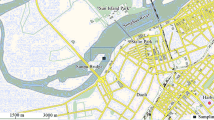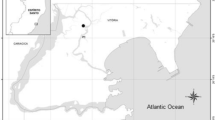Abstract
The concentrations of metals in tissues of Callinectes danae were evaluated, aiming to determine the bioaccumulation process of this species. Gills presented the highest mean concentrations for most metals, except for Hg (<LOD) and Zn (13.293 μg g−1). According to results of the principal component analysis, the type of tissue was distinguished due to the concentrations of metals. An evaluation of individuals from other sites of the Santos Estuarine System (where the Sao Vicente Channel is included) would be important to confirm if this pattern of bioaccumulation can be extended to the population of C. danae of this estuary.
Similar content being viewed by others
Explore related subjects
Discover the latest articles, news and stories from top researchers in related subjects.Avoid common mistakes on your manuscript.
The blue crab Callinectes danae Smith, 1869 is found in brackish water environments such as estuaries and also in marine areas until 75 m depth. The species is distributed throughout the Atlantic Ocean from Florida, USA, to the Southern Coast of Brazil (Melo 1996), including the metropolitan region of Baixada Santista, which is densely urbanized.
Although this region is well known because of its distinct economical significance, it also has noticeable environmental importance since the mangroves of the Santos Estuarine System, which surround the whole area, correspond to 43% of total mangrove area of the Sao Paulo State (Lamparelli et al. 2001).
Despite the implementation of control policies, anomalously high levels of multiple contaminants have still been recorded in the Santos Estuarine System (Luiz-Silva et al. 2008). This setting is historically, economically and environmentally important at a regional scale. Human activities in the estuary started in the beginning of the sixteenth century, right after the arrival of the first Portuguese explorers in Brazil. The most important industrial area of Brazil (the Industrial Complex of Cubatão City) and the largest commercial harbor of the South America (the Harbor of Santos City) are also located inside this estuarine system.
Due to these circumstances and since C. danae survival depends on the environmental quality of this estuary, the concentrations of metals in tissues of the blue crabs must be periodically monitored, since C. danae is an important resource explored by fishermen, mainly from local communities (Severino-Rodrigues et al. 2001).
Virga et al. (2007) and Virga and Geraldo (2008) have already investigated the concentrations of Pb, Cd, Cr, Zn and Cu in individuals of genus Callinectes (including C. danae) from Cubatão River. Besides these studies, few information was published about this species and its relationship with metals released in the Santos Estuarine System, although many studies recorded high concentrations of metals in the local sediment (the species’ habitat) (Bordon et al. 2011).
Thus, this study is a preliminary assessment of metals in tissues of C. danae from the São Vicente Channel, Brazil, aiming to determine the bioaccumulation process of this species.
Materials and Methods
Ten individuals were collected in December/2010 near to the Mariana River (23° 57.521′S, 46° 25.073′O), in the São Vicente Channel, Brazil (Fig. 1). Blue crabs were identified according to Melo (1996) and sex was identified according to Willians (1974). The maturation stage due to the shape and degree of adherence of the abdomen to thoracic sternites, total weight, carapace length and width were measured. Muscles, hepatopancreas and gills were removed by dissection. Samples were carried to the laboratory and stored on −20°C until metal analyses.
Digestion in high pressure microwaves system (CEM Corporation, model MDS—2000) was carried out. Based on method 3052 (USEPA 1996), the acid extraction solution consisted of a mixture containing 5 ml of HNO3 sub boiling, 3 ml of H2O2 and 2 ml of H2O (Milli-Q) with a resistivity 18 MΩ at 25°C. This mixture was added to 0.5–1.0 g of each tissue sample or the certified reference material inside microwave HP-500 vessels (PFA Teflon, fluorocarbon polymer), which were appropriately sealed and heated in the microwave unit. The digestion conducted according the following method: power: 600 W, time of temperature ramp: 10 min; temperature: 145°C; hold time: 4.5 min.
Al, Cd, Cr, Co, Ni and Pb concentrations were determined by HR-ICP-MS Finnigan MAT, model Element. Cu, Fe and Zn concentrations were measured using flame mode of a Fast- Sequential Atomic Absorption Spectroscope Varian, model Spectr-AAS-220-FS. Particularly, Hg concentration was measured by cold vapor generation. Method validation was performed by analyzing certified reference materials Oyster Tissue and Lobster Hepatopancreas (TORT-2). The limit of detection (LOD) for each metal was calculated due the equation:
Mean, mean of concentrations measured in 7 sample blanks; t, t-Student value according to the degrees of freedom (n − 1) and α = 0.05; SD, Standard deviation of concentrations measured in 7 sample blanks.
The principal component analysis (PCA) was used to detect interrelationships among the type of tissue and the concentrations of the target metals.
Results and Discussion
The analyzed individuals were females (Table 1). Only the individual 5 was identified as immature (triangular abdomen sealed to the thoracic sternites). Most of the blue crabs was considered mature (flexible oval abdomen). The individual 10 was the only mature female classified as ovigerous (i.e., carrying eggs inside the abdomen) (Table 1).
The total weight ranged from 11.725 to 89.623 g, with an average of 35.301 ± 6.715 g. Carapace length and width ranged, respectively, from 28.3 to 49.4 mm and from 50.0 to 85.2 mm, with averages of 38.0 ± 1.9 and 64.2 ± 2.9 mm.
The certified standard materials were analyzed in three replicates. The recovery of most of the metals was above 70% (Table 2). With respect to Hg, the obtained concentrations of the Oyster Tissue replicates were below LOD and validation for this element was conducted according to TORT-2 results. Cr presented the lowest recoveries of this study. Due to method 3052, this metal is strongly connected to some refractory compounds that may sequester target elements, explaining these results. The limits of detection for each metal are presented in Table 3.
The concentrations of metals in muscles, gills and hepatopancreas are resumed in Table 4. Gills presented the highest mean concentrations for most metals, except for Hg and Zn (which were found in higher concentrations in muscles and hepatopancreas, respectively).
Based on these results, PCA was applied. In this study, PCA indicated that 10 variables and 30 tissue samples of the blue crabs can be resumed by two significant PC (Principal Components) which presented variance above or close to 10% or eigenvalues above or close to 1. These PC explained together 80% of the total variance in the original data set.
The PC1 summarized information about all metals except Hg and Zn (which are explained by PC2). Correlations of PC1 with each metal are presented, as following: Al (0.947), Cd (0.802), Cr (0.963), Cu (0.648), Co (0.950), Fe (0.943), Ni (0.936), Pb (0.925). Correlations of PC2 with Hg and Zn are presented, as following: Hg (0.916), Zn (−0.471). Figures 2a, b refers to the plots of the scores of PC1 versus PC2.
A group consisting of Al, Fe, Cd, Co, Cr, Cu, Ni and Pb was explained by PC1 (Fig. 2a), indicating metals with high concentrations in gills. Another group consisting of Hg and one last group consisting of Zn (metals with high concentrations in muscles and hepatopancreas, respectively) were explained by PC2. The type of tissue was distinguished due to the concentrations of metals (Fig. 2b).
Few information is available about concentrations of metal in tissues of C. danae and it seems that this is the first record of Al and Co concentrations in tissues of this species. Harris and Santos (2000) also found high concentration of Zn in the hepatopancreas of C. danae, however, Cu, Cd and Fe concentrations were higher in this tissue than in others. Cd, Cr, Cu, Pb and Zn concentrations obtained in this study were similar to those found by Virga et al. (2007) and Virga and Geraldo (2008) in muscles of C. danae collected in the Cubatão River, Brazil. Reichmuth et al. (2010) also found high concentrations of Hg in muscles and high concentrations of Zn in hepatopancreas of Callinectes sapidus. However, Jop et al. (1997) did not found the same pattern assessing metals in Callinectes sapidus tissues. Due to Sastre et al. (1999), the bioaccumulation of metals in crabs of the genus Callinectes is highly variable between sexes, tissues, sites and species. Since this is a preliminary assessment, further efforts must be done in order to provide more information about the bioaccumulation process of C. danae. Also, an evaluation of individuals from other sites of the Santos Estuarine System (where the Sao Vicente Channel is included) would be important to confirm if this pattern of bioaccumulation can be extended to the population of C. danae of this estuary.
References
Bordon ICAC, Sarkis JES, Gobbato GM, Hortellani MA, Peixoto CM (2011) Metal concentration in sediments from the Santos estuarine system: a recent assessment. J Braz Chem Soc 22(10):1858–1865
Harris RR, Santos MCF (2000) Heavy metal contamination and physiological variability in the Brazilian mangrove crabs Ucides cordatus and Callinectes danae (Crustacea: Decapoda). Mar Biol 137(4):691–703
Jop KM, Biever RC, Hoberg JR, Shepherd SP (1997) Analysis of metals in blue crabs, Callinectes sapidus, from two Connecticut estuaries. Bull Environ Contam Toxicol 58:311–317
Lamparelli ML, Costa MP, Prósperi VA, Bevilácqua JE, Araújo RPA, Eysink GGL, Pompéia S (2001) Sistema Estuarino de Santos e São Vicente. CETESB, Sao Paulo
Luiz-Silva W, Machado W, Mattos RHR (2008) Multi-elemental contamination and historic record in sediments from the Santos-Cubatão Estuarine System. Brazil J Braz Chem Soc 19(8):1490–1500
Melo GAS (1996) Manual de identificação dos Brachyura (caranguejos e siris) do litoral brasileiro. Ed Plêiade, FAPESP, Sao Paulo
Reichmuth JM, Weis P, Weis JS (2010) Bioaccumulation and depuration of metals in blue crabs (Callinectes sapidus Rathbun) from a contaminated and clean estuary. Environ Pollut 158:361–368
Sastre MP, Reyes P, Ramos H, Romero R, Rivera J (1999) Heavy metal bioaccumulation in Puerto Rican blue crabs (Callinectes spp). Bull Mar Sci 64(2):209–217
Severino-Rodrigues E, Pita JB, Graça-Lopes R (2001) Pesca artesanal de siris (Crustacea, Portunidae) na região estuarina de Santos e São Vicente (SP). Brasil Bol Inst Pesca 27(1):7–19
USEPA (1996) Method 3052- Microwave assisted acid digestion of siliceous and organically based matrices. Available via http://www.epa.gov/osw/hazard/testmethods/sw846/pdfs/3052.pdf. Accessed 04 Oct 2011
Virga RHP, Geraldo LP (2008) Investigação dos teores de metais pesados em espécies de siris azuis do gênero Callinectes sp. Ciênc Tecnol Aliment 28(4):943–948
Virga RHP, Geraldo LP, Santos FH (2007) Avaliação de contaminação por metais pesados em amostras de siris azuis. Ciênc Tecnol Aliment 27(4):787–792
Willians MJ (1974) The swimming crabs of genus Callinectes (Decapoda: Portunidae). Fish Bull 72:685–789
Acknowledgments
We would like to thank Fundação de Amparo à Pesquisa do Estado de São Paulo (FAPESP) for financial support.
Author information
Authors and Affiliations
Corresponding author
Rights and permissions
About this article
Cite this article
Bordon, I.C.A.C., Sarkis, J.E.S., Tomás, A.R.G. et al. A Preliminary Assessment of Metal Bioaccumulation in the Blue Crab, Callinectes danae S., from the Sao Vicente Channel, Sao Paulo State, Brazil. Bull Environ Contam Toxicol 88, 577–581 (2012). https://doi.org/10.1007/s00128-012-0539-5
Received:
Accepted:
Published:
Issue Date:
DOI: https://doi.org/10.1007/s00128-012-0539-5






